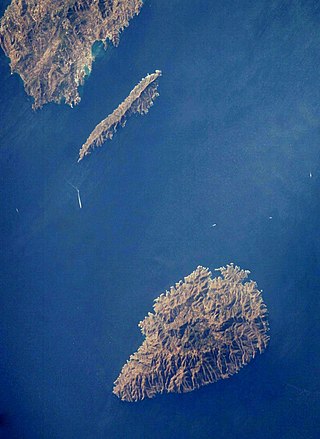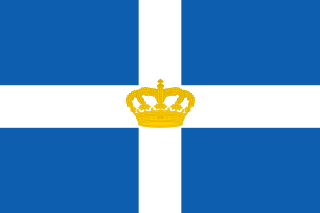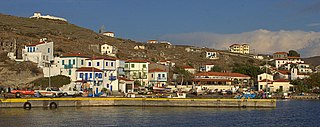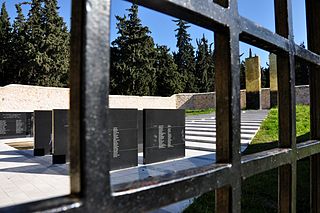
Ioannis Metaxas was a Greek military officer and politician who was Prime Minister of Greece from 1936 until his death in 1941. He governed constitutionally for the first four months of his tenure, and thereafter as the strongman leader of the 4th of August Regime following his appointment by King George II.

Georgios Papandreou was a Greek politician, the founder of the Papandreou political dynasty. He served three terms as prime minister of Greece. He was also deputy prime minister from 1950 to 1952, in the governments of Nikolaos Plastiras and Sofoklis Venizelos. He served numerous times as a cabinet minister, starting in 1923, in a political career that spanned more than five decades.

Makronisos, or Makronisi, is an island in the Aegean sea, in Greece, notorious as the site of a political prison from the 1920s to the 1970s. It is located close to the coast of Attica, facing the port of Lavrio. The island has an elongated shape, 13 km (8 mi) north to south and 2.5 km (1.6 mi) east to west at its widest point, and its terrain is arid and rocky. It is the largest uninhabited Greek island.

Markos Vafeiadis was a leading figure of the Communist Party of Greece (KKE) during the Greek Resistance and the Greek Civil War.

The Greek junta or Regime of the Colonels was a right-wing military dictatorship that ruled Greece from 1967 to 1974. On 21 April 1967, a group of colonels overthrew the caretaker government a month before scheduled elections which Georgios Papandreou's Centre Union was favoured to win.

The 4th of August Regime, commonly also known as the Metaxas regime, was an authoritarian regime under the leadership of General Ioannis Metaxas that ruled the Kingdom of Greece from 1936 to 1941.

Gyaros, also locally known as Gioura, is an arid, unpopulated, and uninhabited Greek island in the northern Cyclades near the islands of Andros and Tinos, with an area of 23 square kilometres (9 sq mi). It is a part of the municipality of Ano Syros, which lies primarily on the island of Syros. This and other small islands of the Aegean Sea served as places of exile for important persons in the early Roman empire. The extremity of its desolation was proverbial among Roman authors, such as Tacitus and Juvenal. It was a place of exile for left-wing political dissidents in Greece from 1948 until 1974. During that time, at least 22,000 people were exiled or imprisoned on the island. It is an island of great ecological importance as it hosts the largest population of monk seals in the Mediterranean.

Agios Efstratios or Saint Eustratius, colloquially Ai Stratis, anciently Halonnesus or Halonnesos, is a small Greek island in the northern Aegean Sea about 30 kilometres southwest of Lemnos and 80 kilometres northwest of Lesbos. The municipality has an area of 43.325 km2. Together with Lemnos and nearby islets it forms the regional unit of Lemnos, part of the Greek archipelagic region of the North Aegean.
Minos Kokkinakis was a Greek member of Jehovah's Witnesses. He is most notable for his repeated clashes with Greece's ban on proselytism.

Aris Alexandrou was a Greek novelist, poet and translator. Always on the Left and always unconventional, he is the author of a single novel which is widely considered to be among the classic modern Greek works in the second half of the 20th century.
Dimitrios Ioannidis, also known as Dimitris Ioannidis and as The Invisible Dictator, was a Greek military officer and one of the leading figures in the junta that ruled the country from 1967 to 1974. Ioannidis was considered a "purist and a moralist, a type of Greek Gaddafi".

Yiannis Ritsos was a Greek poet and communist and an active member of the Greek Resistance during World War II. While he disliked being regarded as a political poet, he has been called "the great poet of the Greek left".

The history of the Hellenic Republic constitutes three republican periods in the modern history of Greece: from 1822 until 1832; from 1924 until 1935; and from 1974 through to the present. See also the constitutional history of Greece.
Ilias Iliou was a Greek lawyer and politician, member of the Greek Parliament and leader of the United Democratic Left (EDA). He was also a distinguished writer and jurist.

On 1 May 1944, 200 Greek communists were executed at the firing range of the Athens suburb of Kaisariani by the Nazi occupation authorities as reprisal for the killing of a German general by Greek Resistance forces.
The Lebanon conference was held on May 17–20, 1944, between representatives of the Greek government in exile, the pre-war Greek political parties, and the major Greek Resistance organizations, with the British ambassador Reginald Leeper in attendance. The conference occurred after an anti-monarchist mutiny among the Greek military the previous month. PM Georgios Papandreou's policy was to create a National Unity government with the participation of the communist-dominated EAM. Finally there was a partial agreement, though tensions and disagreements remained.

A prison island is an island housing a prison. Islands have often been used as sites of prisons throughout history due to their natural isolation preventing escape.

Napoleon Soukatzidis was a Greek communist, trade unionist and one of the 200 prisoners executed at the firing range of the Athens suburb of Kaisariani by the Nazi occupation forces on May 1, 1944.
White Terror is the term used in Greece, analogous to similar cases, for the period of persecution of members of the Communist Party of Greece (KKE) and other former members of the leftist World War II-era resistance organization National Liberation Front (EAM) in 1945–46, prior to the outbreak of the Greek Civil War.

The Massacre of the First Sapper Battalion was the mass murder of 350 Greek soldiers imprisoned in the Makronisos prison island perpetrated by the camp guards and prisoner functionaries belonging to the Third Sapper Battalion. The massacre took place between 29 February and 1 March 1948, during the Greek Civil War.



















